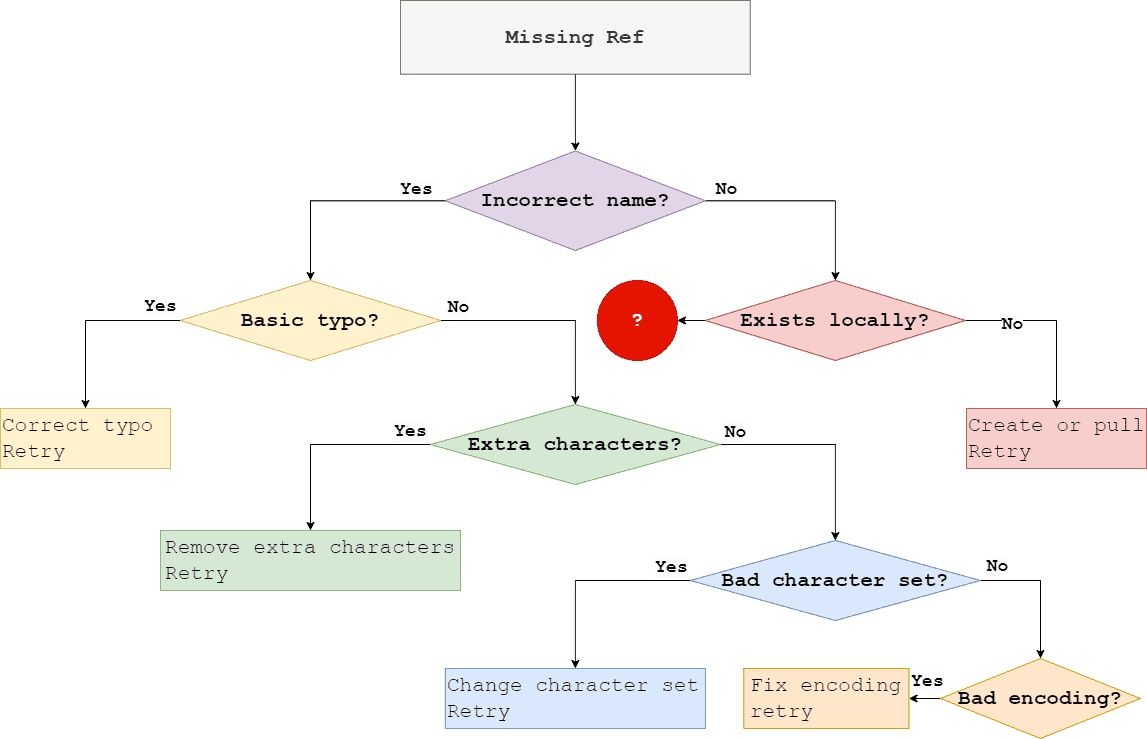1. 引言
Git 作为一个完整的版本控制系统,支持解决对象版本之间的冲突,包括分支、提交以及其他引用(ref)。但在某些场景下,我们可能会遇到与 ref 相关的问题,比如在合并或执行其他涉及 ref 的操作时出现错误。
本文将深入探讨 Git 中由于 ref 缺失导致的常见错误,包括:
not something we can mergedid not match any file(s) known to git
我们会通过创建本地和远程仓库来演示问题,并分析 refs 是如何同步的。最终我们会总结出解决这类问题的完整思路。
我们使用的测试环境为 Debian 12 (Bookworm),Bash 5.2.15 和 Git 2.39.2。除非特别说明,大部分命令在大多数 POSIX 兼容环境中均可运行。
2. 缺失 Ref 的常见原因
导致 Git ref 问题的两个主要原因如下:
- 本地不存在该 ref(例如分支或标签未被拉取)
- ref 名称错误(拼写错误或字符编码问题)
下面是一个用于排查 ref 问题的流程图,帮助我们快速定位问题根源:

有了这个思路,我们可以更系统地处理问题。
3. Ref 名称错误
Git 本身不会自动纠正拼写错误,尤其是在处理自定义的分支名、标签名时。常见的拼写错误包括:
- 字符缺失或拼写错误
- 多余字符(包括控制字符或隐藏字符)
- 使用了形似但不同的字符(如西里尔字母的
с与拉丁字母的c) - 使用了不兼容的字符集(如在 ASCII 环境中使用 Emoji)
✅ 解决建议:
- 利用 Git 的自动补全功能(Tab 键)来避免拼写错误
- 使用
cat -A查看隐藏字符
示例:
$ printf 'CС' | cat -A
CM-PM-!
这说明两个字符看似相同,实则不同,容易导致 ref 识别失败。
4. Git Refs 与远程仓库
Git 中的 ref 主要有以下三类:
- 分支(branch):如
master、feature-branch - 特殊 ref:如
HEAD - 标签(tag):如
v1.0.0
这些 ref 本质上是为了方便操作,避免我们手动使用 commit hash。
示例:查看当前仓库的 ref 结构
$ git log --all --decorate --oneline --graph
* fee1bab (branch1) branch feature
| * 349648c (tag: v0.1, branch2) secondary feature WIP
| * 5d3772e secondary branch modifications
|/
| * 536f16d (branch3) experimental
|/
* f30c039 branch modifications
| * d8c10fe (HEAD -> master) new structure
| * 19649bf wipeout
| * b0d6c31 major modifications
| * 3ce9677 minor modifications
|/
* f721f76 restructuring
* 6cb76f5 structuring
* bb75656 init commit
查看 .git/refs 目录结构:
.git/refs/
├── heads
│ ├── branch1
│ ├── branch2
│ ├── branch3
│ └── master
└── tags
└── v0.1
添加远程仓库并推送主分支
$ git remote add origin ../remote/
$ git push --set-upstream origin master
此时 .git/refs/remotes/origin/master 被创建,但其他分支和标签未被同步。
5. 远程 Ref 同步机制
我们新建一个空的本地仓库,并将远程仓库设置为 origin:
$ git init && git remote add origin ../remote/
$ git pull
输出提示我们需要指定要拉取的分支:
There is no tracking information for the current branch.
Please specify which branch you want to merge with.
此时 .git/refs/remotes/origin/master 已存在,但本地没有 master 分支。
我们手动拉取并创建本地分支:
$ git pull origin master
From ../remote
* branch master -> FETCH_HEAD
现在本地有了 master 分支,但其他分支(如 branch1, branch2)仍不存在。
6. 常见 Ref 缺失错误示例
6.1 创建新分支并尝试合并
我们在第二个仓库中创建 branch1 并提交修改:
$ git branch branch1
$ git checkout branch1
Switched to branch 'branch1'
$ echo 'branch1 data' >> file
$ git commit --all --message='testing branch1'
尝试合并远程的 origin/branch1:
$ git merge origin/branch1
merge: origin/branch1 - not something we can merge
❌ 报错原因:远程没有 branch1 分支。
6.2 拉取远程分支失败
$ git pull origin branch1
fatal: couldn't find remote ref branch1
❌ 报错原因:远程仓库没有 branch1 分支。
6.3 分支不存在本地
$ git checkout branch2
error: pathspec 'branch2' did not match any file(s) known to git
❌ 报错原因:本地没有 branch2 分支。
6.4 推送所有分支到远程
在原始仓库中推送所有分支和标签:
$ git push --all
$ git push --tags
验证远程仓库 ref 结构:
../remote/.git/refs/
├── heads
│ ├── branch1
│ ├── branch2
│ ├── branch3
│ └── master
└── tags
└── v0.1
✅ 此时远程仓库包含所有 ref。
6.5 从第二个仓库拉取所有数据
$ git pull --all
输出显示远程分支被拉取为 origin/branchX,但本地仍需手动 checkout:
$ git checkout branch2
此时 .git/refs/heads/branch2 被创建。
6.6 验证合并操作
现在我们可以合并任何远程分支:
$ git merge origin/branch3
Auto-merging file
✅ 成功合并,即使 branch3 未被本地 checkout。
7. 总结
Git 中的 ref 问题常见于分支和标签名称错误或同步不全。以下是关键点总结:
✅ ref 名称错误排查:
- 使用 Tab 自动补全避免拼写错误
- 使用
cat -A查看隐藏字符 - 检查字符编码是否一致
✅ ref 同步问题排查:
- 默认
git push只推送当前分支 - 使用
--all推送所有分支,--tags推送所有标签 - 使用
git pull --all获取所有远程 ref - 本地分支需手动 checkout 或设置 upstream
❌ 常见错误:
not something we can merge:远程分支未拉取did not match any file(s) known to git:本地没有该分支或标签
掌握这些技巧,可以避免在 Git 使用过程中频繁踩坑。